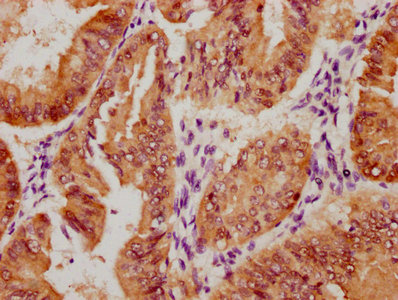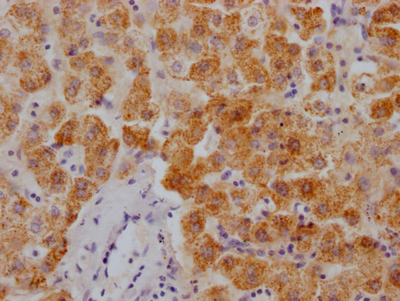PTGER3 Antibody
-
中文名稱:PTGER3兔多克隆抗體
-
貨號:CSB-PA040060
-
規格:¥1090
-
其他:
產品詳情
-
Uniprot No.:
-
基因名:
-
別名:PTGER3; Prostaglandin E2 receptor EP3 subtype; PGE receptor EP3 subtype; PGE2 receptor EP3 subtype; PGE2-R; Prostanoid EP3 receptor
-
宿主:Rabbit
-
反應種屬:Human
-
免疫原:Synthesized peptide derived from the N-terminal region of Human EP3.
-
免疫原種屬:Homo sapiens (Human)
-
標記方式:Non-conjugated
-
抗體亞型:IgG
-
純化方式:The antibody was affinity-purified from rabbit antiserum by affinity-chromatography using epitope-specific immunogen.
-
濃度:It differs from different batches. Please contact us to confirm it.
-
保存緩沖液:Liquid in PBS containing 50% glycerol, 0.5% BSA and 0.02% sodium azide.
-
產品提供形式:Liquid
-
應用范圍:WB, IHC, IF, ELISA
-
推薦稀釋比:
Application Recommended Dilution WB 1:500-1:2000 IHC 1:100-1:300 IF 1:200-1:1000 ELISA 1:20000 -
Protocols:
-
儲存條件:Upon receipt, store at -20°C or -80°C. Avoid repeated freeze.
-
貨期:Basically, we can dispatch the products out in 1-3 working days after receiving your orders. Delivery time maybe differs from different purchasing way or location, please kindly consult your local distributors for specific delivery time.
-
用途:For Research Use Only. Not for use in diagnostic or therapeutic procedures.
相關產品
靶點詳情
-
功能:Receptor for prostaglandin E2 (PGE2). The activity of this receptor can couple to both the inhibition of adenylate cyclase mediated by G(i) proteins, and to an elevation of intracellular calcium. Required for normal development of fever in response to pyrinogens, including IL1B, prostaglandin E2 and bacterial lipopolysaccharide (LPS). Required for normal potentiation of platelet aggregation by prostaglandin E2, and thus plays a role in the regulation of blood coagulation. Required for increased HCO3(-) secretion in the duodenum in response to mucosal acidification, and thereby contributes to the protection of the mucosa against acid-induced ulceration. Not required for normal kidney function, normal urine volume and osmolality.
-
基因功能參考文獻:
- In sporadic breast cancer, EP3 receptor expression is not significantly associated with clinicopathological parameters but is a significant prognostic factor for improved progression-free and overall survival. However, the functional aspects of EP3 receptor in breast cancer and the way how EP3 may oppose the pro-tumorigenic effects of PGE2 elevation and COX-2 overexpression are not fully understood so far. PMID: 29661238
- Study reports that EP3 expression is elevated in TSC2- deficient patient-derived cells compared with TSC2-addback cells, and that EP3 antagonist selectively suppresses the proliferation of TSC2-deficient cells. The elevated expression of EP3 is mediated by Rheb in an mTORC1-independent fashion. PMID: 28710231
- Study showed the EP3 expression is correlated to the FIGO classification and, demonstrates that an increased EP3 expression correlates with a negative outcome of overall survival of cervical carcinoma patients. In addition, different expression of EP3 was found in correlation to the histological subtype. Patients with adenocarcinoma and high expression of EP3 had a worse outcome survival. PMID: 28753926
- Its signaling pathway impairs hippocampal presynaptic long-term plasticity in Alzheimer's disease. PMID: 27837675
- findings show that prostaglandin E2 EP3 receptor contributes to thrombin-induced brain damage via Rho-Rho kinase-mediated cytotoxicity and proinflammatory responses. PMID: 26661165
- S211L within EP3 is the key residue to distinguish PGE1 and PGE2 binding to mediate diverse biological functions at the initial recognition step PMID: 28065721
- The present study identified the functions of EP3 and the mechanisms by which PGE2 regulates beta-catenin expression and promoted cholangiocarcinoma cell growth and invasion PMID: 26058972
- results demonstrate that risk of unsuccessful periodontal treatment is associated with tag SNPs in specific genes that regulate the inflammatory response, one of which is also associated with sPTB. PMID: 23805813
- Failure of cervical ripening, after local application of prostaglandins for labor induction, may be caused by the increased expression of EP3 and concomitant decrease in EP4 expression. PMID: 24180609
- Human prostate cancer is associated with EP4 and EP2 overexpression and reduced EP3 expression. PMID: 23364535
- EP3 downregulation contributed to prostate carcinogenesis and to progression from androgen-dependent prostate cancer to castration-resistant prostate cancer by regulating androgen receptor expression. PMID: 23493387
- Neuronal prostaglandin E2 receptor subtype EP3 mediates antinociception during inflammation. PMID: 23904482
- Prostaglandin E2 receptor, EP3, is induced in diabetic islets and negatively regulates glucose- and hormone-stimulated insulin secretion. PMID: 23349487
- EP(3) receptors located postsynaptically strongly contract human pulmonary arteries. PMID: 23406763
- This study identify the PGE(2) EP3 receptor as a novel proinflammatory, proamyloidogenic, and synaptotoxic signaling pathway, and suggest a role for COX-PGE(2) -EP3 signaling in the development of AD. PMID: 22915243
- laropiprant by itself attenuated platelet activation induced by thromboxane (TP) and E-type prostanoid (EP)-3 receptor stimulation, as demonstrated in assays of platelet aggregation PMID: 22870195
- epistatic interaction with prostaglandin E receptor 3 gene confers an increased risk for Stevens-Johnson syndrome with severe ocular surface complications PMID: 22421267
- Prostaglandin E2 induced contraction of human intercostal arteries is mediated by the EP3 receptor PMID: 22342278
- The levels of prostaglandin-endoperoxide synthase 1 (PTGS1; aka COX-1) and prostaglandin-endoperoxide receptor 3 (PTGER3) mRNA are increased in patient with schizophrenia. PMID: 22397921
- EP3 is the primary receptor subtype that mediates PGE(2) induced contractility in human pregnant myometrium at term and represents a possible therapeutic target. PMID: 22162473
- Data posit an association between the down-regulation of EP3 in conjunctival epithelium and the pathogenesis and pathology of SJS/TEN and OCP, and suggest a common mechanism(s) in the pathology of these diseases. PMID: 21966456
- A positive feedback pathway involving COX-2/PGE2/EP3 receptor-dependent EGFR reactivation exaggerates IL-8 production in NCI-H292 cancer cells but not in NHBE (normal) cells. PMID: 21925169
- The role of PGE(2) in human atherosclerotic plaque on platelet EP(3) and EP(4) receptor activation and platelet function in whole blood. PMID: 21424266
- lower levels in the conjunctival epithelial cells of Stevens-Johnson syndrome patients PMID: 20947153
- downregulated in endometriosis tissues PMID: 20452033
- Studies indicate assocation of PTGER3 and PON1 genotypes with preterm birth. PMID: 20140262
- EP3 regulates VM and the associated increased MMP-2 enzyme activity. PMID: 20503412
- The present results address the novel activities of COX-2/PGE2-EP3/EP4 signaling that modulate tumor biology and show that CXCL12/CXCR4 axis may play a crucial role in tumor stromal formation and angiogenesis under the control of prostaglandins. PMID: 20110411
- EP3 receptor signaling on endothelial cells is essential for the MMP-9 upregulation that enhances tumor metastasis and angiogenesis. PMID: 19799610
- expression of prostaglandin E receptor 3-2 was significantly lower in gravid than nongravid myometrium while levels of the prostaglandin E receptor 3-6 message were higher in gravid samples than in nongravid specimens PMID: 12699873
- An agonist of EP(3), an inhibitory pathway, antagonized activity levels induced by PGE(2). Generally reflective of changes in aromatase protein expression and the pattern of mRNA expression. PMID: 12788892
- EP3 and EP4 mediate different actions of PGE2 on mature human osteoclasts. Activation of EP4 receptors inhibits actin ring formation and activation of EP3 receptors increases number of lamellipodia. PMID: 15290741
- When expressed in HEK293 cells, the isoforms located to the cell surface, although a fraction of some remained in the cell. PMID: 15304361
- Prostaglandin (PG)E2 augments intracellular calcium levels in the T-leukemic cell line Jurkat through the E-prostanoid (EP)3 receptor. PMID: 15528329
- EP3 receptors produce epidermal growth inhibition through the action of Ddiacylglycerol and ceramide second messengers. PMID: 16274459
- analysis of a prostaglandin EP3alpha receptor intracellular loop peptide by NMR PMID: 16707103
- the association between EH and nucleotide polymorphisms in the gene encoding the prostaglandin E2 receptor subtype EP2 (PTGER2). PMID: 17644362
- Study indicates that genetic variations (single nucleotide polymorphism 1388T>C) in the Ptger3 gene are significantly associated with the risk and severity of asthma in the Korean population. PMID: 17877755
- We identified a new mRNA splice variant of the EP3 gene in human gastric fundic mucosa, mammary artery and pulmonary vessels. This EP3-Ic transcript contains exons 1, 2, 3, 5 and 6 of the EP3 gene and should be translated in the EP3-I isoform. PMID: 18023986
- results showed that EP3 is expressed in trigeminal neurons (53% of total neurons), and is co-expressed in TRPV(1)-positive neurons (67 % of TRPV(1)-positive neurons. PMID: 18296611
- Data suggest that expression of prostanoid receptors (prostaglandin E2 EP3-I, prostacyclin, and thromboxane A2 receptors) in vascular inflammation could influence cell responses dependent on the constitutive activation of ghrelin receptors. PMID: 18573679
- EP3 receptors are involved in bladder micturition at supraspinal and spinal centers and in bladder nociception at the spinal cord PMID: 18632791
- This study found that the non-conserved S211 and R214 of the hEP3 are involved in PGE(2) recognition. PMID: 18652829
- Stimulation of the EP3(I) isoform of the human EP3 receptor with prostaglandin E(2) increases the mRNA expression of both VEGF and its cognate receptor VEGF receptor-1. PMID: 18996083
- examined the contributions of EP3 to platelet function using the selective EP3 agonist sulprostone and also PGE(2) PMID: 19012178
- In human parturition, there is decreased mRNA expression of lower-uterine segment EP3 receptor isoforms II and VI during labour. PMID: 19165680
顯示更多
收起更多
-
亞細胞定位:Cell membrane; Multi-pass membrane protein.
-
蛋白家族:G-protein coupled receptor 1 family
-
組織特異性:Detected in kidney. Expressed in small intestine, heart, pancreas, gastric fundic mucosa, mammary artery and pulmonary vessels.
-
數據庫鏈接:
Most popular with customers
-
YWHAB Recombinant Monoclonal Antibody
Applications: ELISA, WB, IHC, IF, FC
Species Reactivity: Human, Mouse, Rat
-
Phospho-YAP1 (S127) Recombinant Monoclonal Antibody
Applications: ELISA, WB, IHC
Species Reactivity: Human
-
-
-
-
-
-



















